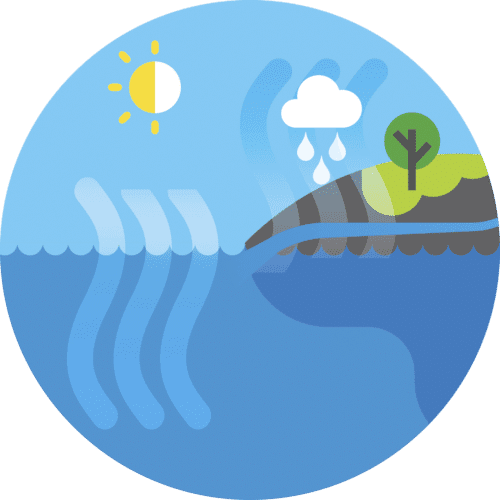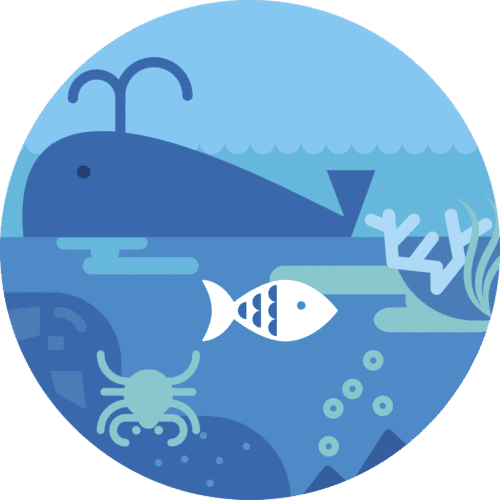The 7 principles of ocean literacy
-
Earth has one big ocean with many features.
![01-principi-Oceano]()
The ocean is the defining physical feature on our planet Earth—covering approximately 70% of the planet’s surface. There is one ocean with many ocean basins, such as the North Pacific, South Pacific, North Atlantic, South Atlantic, Indian, Southern and Arctic.
Ocean basins are composed of the seafloor and all of its geological features (such as islands, trenches, mid-ocean ridges and rift valleys) and vary in size , shape and features due to the movement of Earth’s crust (lithosphere). Earth’s highest peaks, deepest valleys and flattest vast plains are all in the ocean.
Throughout the ocean there is one interconnected circulation system powered by wind, tides, the force of the Earth’s rotation (Coriolis effect), the Sun, and water density differences. The shape of ocean basins and adjacent land masses influence the path of circulation. This ‘global ocean conveyor belt’ moves water throughout all of the ocean’s basins, transporting energy (heat), matter, and organisms around the ocean. Changes in ocean circulation have a large impact on the climate and cause changes in ecosystems.
Sea level is the average height of the ocean relative to the land, taking into account the differences caused by tides. Sea level changes as plate tectonics cause the volume of ocean basins and the height of the land to change. It changes as ice caps on land melt or grow. It also changes as sea water expands and contracts when ocean water warms and cools.
Most of Earth’s water (97%) is in the ocean. Seawater has unique properties: it is saline, its freezing point is slightly lower than fresh water, its density is slightly higher, its electrical conductivity is much higher, and it is slightly basic. The salt in seawater comes from eroding land, volcanic emissions, reactions at the seafloor, and atmospheric deposition.
The ocean is an integral part of the water cycle and is connected to all of the earth’s water reservoirs via evaporation and precipitation processes.
The ocean is connected to major lakes, watersheds and waterways because all major watersheds on Earth drain to the ocean. Rivers and streams transport nutrients, salts, sediments and pollutants from watersheds to estuaries and to the ocean.
Although the ocean is large, it is finite and resources are limited. -
The ocean and life in the ocean shape the features of the Earth
![02-principi-Oceano]()
Many earth materials and geochemical cycles originate in the ocean. Many of the sedimentary rocks now exposed on land were formed in the ocean. Ocean life laid down the vast volume of siliceous and carbonate rocks.
Sea level changes over time have expanded and contracted continental shelves, created and destroyed inland seas, and shaped the surface of land.
Erosion—the wearing away of rock, soil and other biotic and abiotic earth materials—occurs in coastal areas as wind, waves, and currents in rivers and the ocean move sediments.
Sand consists of tiny bits of animals, plants, rocks and minerals. Most beach sand is eroded from land sources and carried to the coast by rivers, but sand is also eroded from coastal sources by surf. Sand is redistributed by waves and coastal currents seasonally.
Tectonic activity, sea level changes, and force of waves influence the physical structure and landforms of the coast.
-
The ocean is a major influence on weather and climate
![03-principi-Oceano]()
The ocean interaction of oceanic and atmospheric processes controls weather and climate by dominating the Earth’s energy, water and carbon systems.
The ocean moderates global weather and climate by absorbing most of the solar radiation reaching Earth. Heat exchange between the ocean and atmosphere drives the water cycle and oceanic and atmospheric circulation.
Heat exchange between the ocean and atmosphere can result in dramatic global and regional water phenomena, impacting patterns of rain and drought. Significant examples include the El Niño Southern Oscillation and La Niña, which causes important changes in global weather patterns because they alter the sea surface temperature patterns in the Pacific.
Condensation of water that evaporated from warm seas provides the energy for hurricanes and cyclones. Most rain that falls on land originally evaporated from the tropical ocean.
The ocean dominates the Earth’s carbon cycle. Half the primary productivity on Earth takes place in the sunlit layers of the ocean and the ocean absorbs roughly half of all carbon dioxide added to the atmosphere.
The ocean has had, and will continue to have, a significant influence on climate change by absorbing, storing, and moving heat, carbon and water. Changes in the ocean’s circulation have produced large, abrupt changes in climate during the last 50,000 years.
Changes in the ocean-atmosphere system can result in changes to the climate that in turn, cause further changes to the ocean and atmosphere. These interactions have dramatic physical, chemical, biological, economic, and social consequences. -
The ocean makes Earth habitable.
![04-principi-Oceano]()
Most of the oxygen in the atmosphere originally came from the activities of photosynthetic organisms in the ocean. This accumulation of oxygen in Earth’s atmosphere was necessary for life to develop and be sustained on land.
The first life is thought to have started in the ocean. The earliest evidence of life is found in the ocean.
The ocean provided and continues to provide water, oxygen and nutrients, and moderates the climate needed for life to exist on Earth (Essential Principles 1,3, and 5). -
The ocean supports a great diversity of life and ecosystems
![05-principi-Oceano]()
Ocean life ranges in size from the smallest living things, microbes, to the largest animal that has lived on Earth, blue whales.
Most of the organisms and biomass in the ocean are microbes, which are the basis of all ocean food webs. Microbes are the most important primary producers in the ocean. They have extremely fast growth rates and life cycles, and produce a huge amount of the carbon and oxygen on Earth.
Most of the major groups that exist on Earth are found exclusively in the ocean and the diversity of major groups of organisms is much greater in the ocean than on land.
Ocean biology provides many unique examples of life cycles, adaptations and important relationships among organisms (symbiosis, predator-prey dynamics, and energy transfer) that do not occur on land.
The ocean provides a vast living space with diverse and unique ecosystems from the surface through the water column and down to, and below, the seafloor. Most of the living space on Earth is in the ocean.
Ocean ecosystems are defined by environmental factors and the community of organisms living there. Ocean life is not evenly distributed through time or space due to differences in abiotic factors such as oxygen, salinity, temperature, pH, light, nutrients, pressure, substrate and circulation. A few regions of the ocean support the most abundant life on Earth, while most of the ocean does not support much life.
There are deep ocean ecosystems that are independent of energy from sunlight and photosynthetic organisms. Hydrothermal vents, submarine hot springs, and methane cold seeps rely only on chemical energy and chemosynthetic organisms to support life.
Tides, waves, predation, substrate, and/or other factors cause vertical zonation patterns along the coast: density, pressure, and light levels cause vertical zonation patterns in the open ocean. Zonation patterns influence organisms’ distribution and diversity.
Estuaries provide important and productive nursery areas for many marine and aquatic species. -
The ocean and humans are inextricably interconnected
![06-principi-Oceano]()
The ocean affects every human life. It supplies freshwater (most rain comes from the ocean) and nearly all Earth’s oxygen. The ocean moderates the Earth’s climate, influences our weather, and affects human health.
The ocean provides foods, medicines, and mineral and energy resources. It supports jobs and national economies, serves as a highway for transportation of goods and people, and plays a role in national security.
The ocean is a source of inspiration, recreation, rejuvenation and discovery. It is also an important element in the heritage of many cultures.
Humans affect the ocean in a variety of ways. Laws, regulations and resource management affect what is taken out and put into the ocean. Human development and activity leads to pollution (point source, non-point source, and noise pollution), changes to ocean chemistry (ocean acidification) and physical modifications (changes to beaches, shores and rivers). In addition, humans have removed most of the large vertebrates from the ocean.
Changes in ocean temperature and pH due to human activities can affect the survival of some organisms and impact biological diversity (coral bleaching due to increased temperature and inhibition of shell formation due to ocean acidification).
Much of the worlds population lives in coastal areas. Coastal regions are susceptible to natural hazards (tsunamis, hurricanes, cyclones, sea level change, and storm surges).
Everyone is responsible for caring for the ocean. The ocean sustains life on Earth and humans must live in ways that sustain the ocean. Individual and collective actions are needed to effectively manage ocean resources for all.
-
The ocean is largely unexplored
![07-principi-Oceano]()
The ocean is the largest unexplored place on Earth—less than 20% of it has been explored. The next generation of explorers and researchers will find great opportunities for discovery, innovation and investigation.
Understanding the ocean is more than a matter of curiosity. Exploration, experimentation, and discovery are required to better understand ocean systems and processes.
Over the last 50 years, use of ocean resources has increased significantly, the future sustainability of ocean resources depends on our understanding of those resources and their potential.
New technologies, sensors and tools are expanding our ability to explore the ocean system. Scientists are relying more and more on satellites, drifters, buoys, subsea observatories and unmanned submersibles.
Use of mathematical models is an essential part of the ocean systems. Models help us understand the complexity of the ocean and of its interaction with Earth’s interior, atmosphere, climate and land masses.
Ocean exploration is truly interdisciplinary. It requires close collaboration among biologists, chemists, climatologists, computer programmers, engineers, geologists, meteorologists, physicists, animators and illustrators. And these interactions foster new ideas and new perspectives for inquiries.






